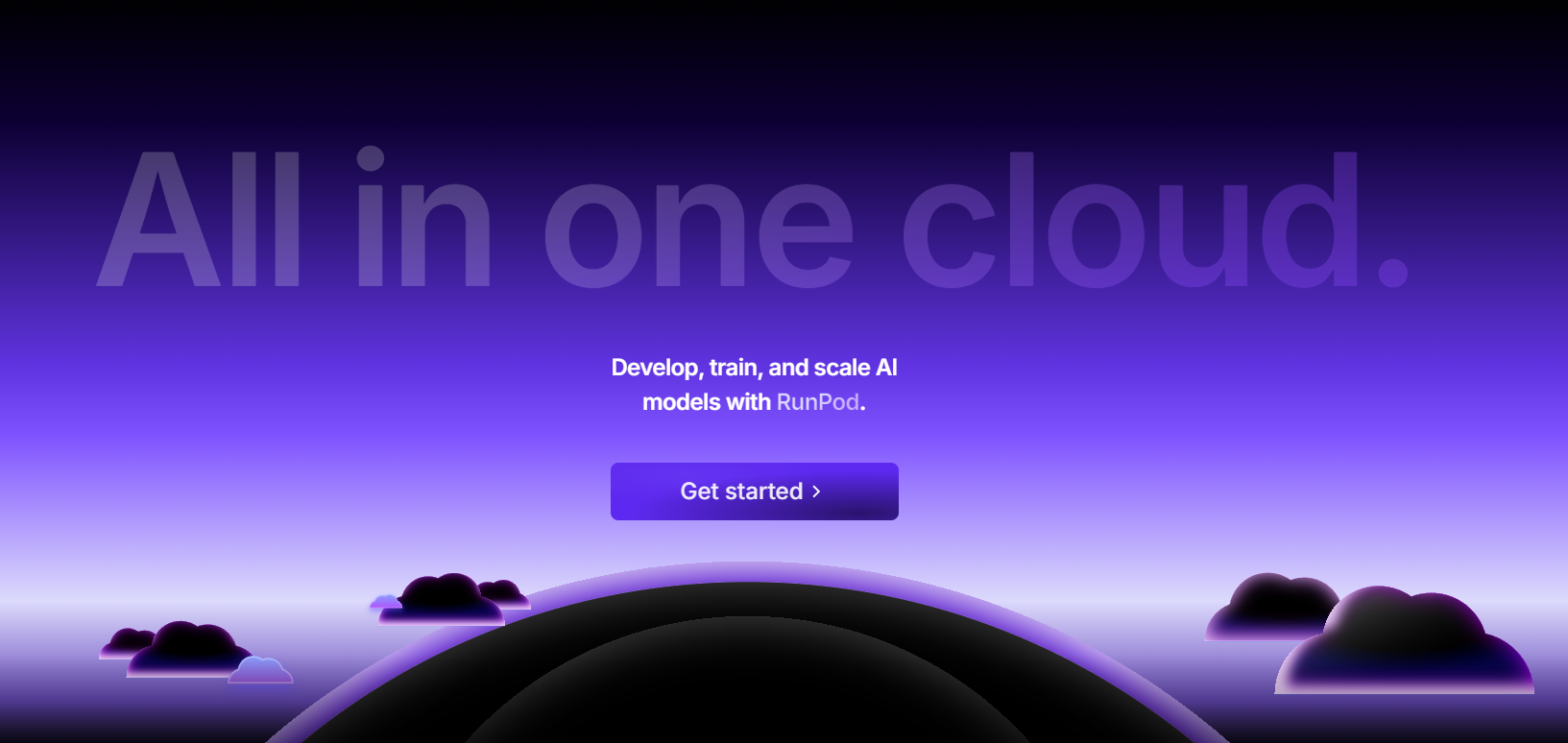In the fast-evolving world of artificial intelligence and machine learning, access to powerful hardware is crucial. Runpod Review aims to shed light on a cloud-based service that offers affordable and scalable GPU resources.
Whether you’re training complex neural networks, rendering 3D graphics, or conducting data analysis, Runpod provides the computational power you need without the hefty upfront costs associated with physical hardware. In this comprehensive review, we will explore the features, pricing, performance, and user experience of Runpod to help you decide if it’s the right solution for your computational needs.
Table of Contents
What is Runpod?
Runpod is a cloud computing platform that specializes in providing on-demand access to powerful GPUs for a variety of applications. It offers a flexible and cost-effective solution for anyone needing significant computing power without investing in expensive hardware. The platform is designed to cater to a wide range of users, from AI researchers and data scientists to game developers and video editors.
Why Runpod?
The demand for cloud computing services has been on the rise, driven by the growth of data-intensive applications. According to a report by Grand View Research, the global cloud computing market size was valued at $368.97 billion in 2021 and is expected to expand at a compound annual growth rate (CAGR) of 15.7% from 2022 to 2030. Runpod aims to capture a share of this market by offering GPU resources that are not only powerful but also easy to use and highly customizable. The platform is especially appealing to users who require high-performance computing on a pay-as-you-go basis, making it accessible and affordable for projects of all sizes.
Key Features of Runpod
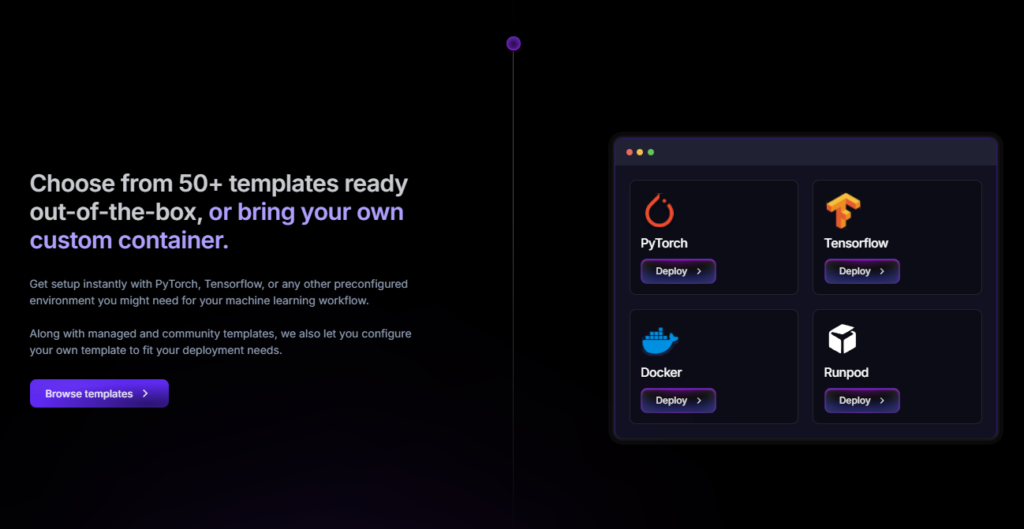
One of the most important aspects of a Runpod review is understanding the features that set it apart from other cloud computing platforms. Here’s a look at some of the key features:
1. On-Demand GPU Instances
Runpod offers on-demand GPU instances that can be deployed quickly for various applications. You can choose from a variety of GPU models, including popular options like the NVIDIA RTX and Tesla series. This flexibility allows users to select the right GPU for their specific needs, whether it’s deep learning, gaming, or scientific computation.
2. Scalability
One of Runpod’s main advantages is its scalability. You can easily scale up or down depending on your project’s requirements. This is particularly useful for AI researchers who need to scale their computational resources during different phases of model training and testing.
3. User-Friendly Interface
Runpod’s web-based dashboard is designed to be intuitive, making it easy for both beginners and experienced users to manage their resources. The dashboard allows you to monitor usage, control instances, and access billing information in a straightforward manner.
4. Pre-Configured Environments
Runpod offers a range of pre-configured environments for popular machine learning frameworks like TensorFlow, PyTorch, and Keras. This saves time on setup and allows you to get started with your projects almost immediately.
5. API Integration
For advanced users, Runpod provides robust API integration. This feature allows you to automate the deployment and management of GPU instances, making it easier to integrate Runpod into your existing workflows and applications.
6. Cost-Efficiency
Runpod’s pay-as-you-go model ensures that you only pay for the resources you use. This is a significant advantage for users who don’t need constant access to powerful GPUs but still require them for specific tasks.
Pricing Structure of Runpod
In this Runpod review, understanding the pricing structure is crucial for determining whether the platform offers good value for money. Runpod’s pricing is based on the type of GPU instance you choose, the duration of usage, and any additional storage or data transfer fees.
1. GPU Pricing
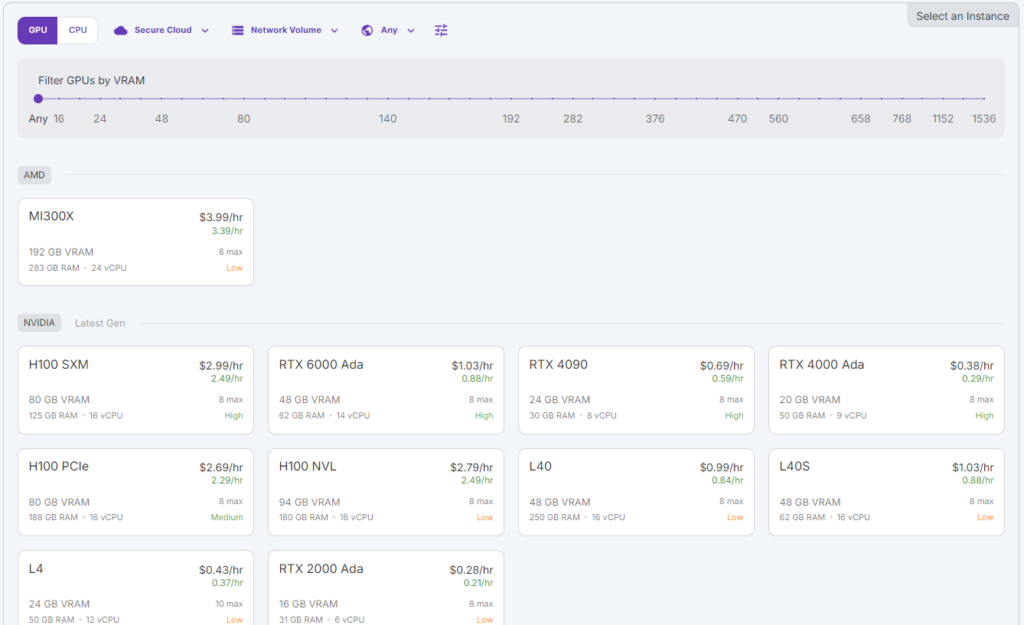
Runpod offers a variety of GPU instances at different price points:
- NVIDIA GTX 1080/RTX 2080: Starting at around $0.30/hour. Ideal for less intensive tasks like small-scale machine learning experiments and 3D rendering.
- NVIDIA RTX 3090/Tesla T4: Ranges from $0.60 to $1.00/hour. Suitable for more complex tasks like model training and video processing.
- NVIDIA Tesla V100/A100: High-end GPUs starting from $2.00/hour, perfect for large-scale deep learning and scientific simulations.
You can also check out the best Nvidia Tesla V100 providers.
2. Storage and Data Transfer
Runpod also charges for storage and data transfer, which are typically priced separately from the GPU instances. Storage is available in multiple tiers, with higher costs associated with faster access speeds and greater capacity.
- Storage Costs: Typically start at $0.10 per GB per month.
- Data Transfer Fees: Vary depending on the amount of data being transferred and the regions involved.
3. Discounts and Offers
Runpod frequently offers discounts for long-term use and bulk purchases. Users who commit to using the platform for extended periods can benefit from reduced hourly rates and storage costs.
Performance Evaluation
In any Runpod review, performance is a critical factor, especially for users relying on the platform for high-stakes computational tasks. Below, we delve into various performance aspects of Runpod.
1. Speed and Latency
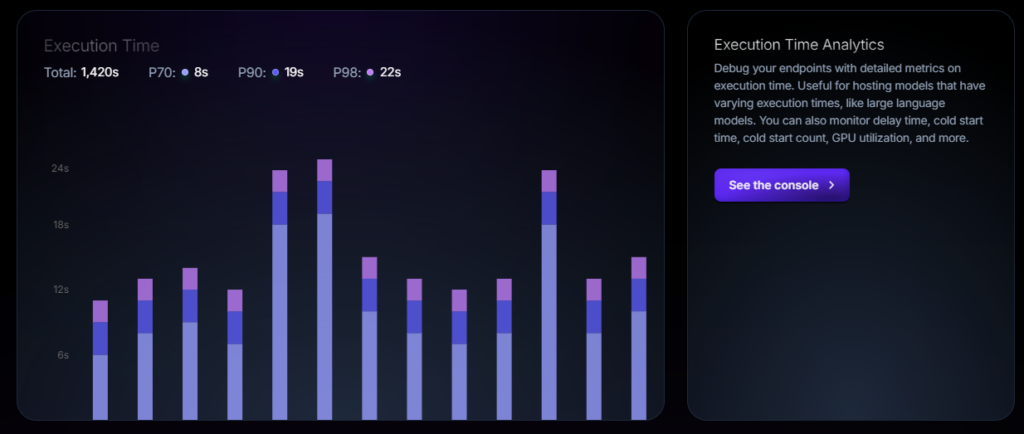
Runpod’s GPU instances are known for their speed and low latency, making them suitable for real-time applications. During testing, instances like the RTX 3090 and Tesla V100 showed impressive performance in training complex deep learning models, with minimal delays in data processing.
2. Reliability and Uptime
Runpod offers a high level of reliability with a stated uptime of 99.9%. This makes it a dependable choice for projects that require consistent access to computational resources. The platform also provides automated failover mechanisms, ensuring that your tasks continue to run smoothly even in the event of hardware failures.
3. Scalability and Flexibility

The platform’s scalability allows users to quickly adjust resources based on their needs. This is particularly useful for AI researchers and developers who need to scale up during peak training periods and scale down during testing or idle times.
User Experience
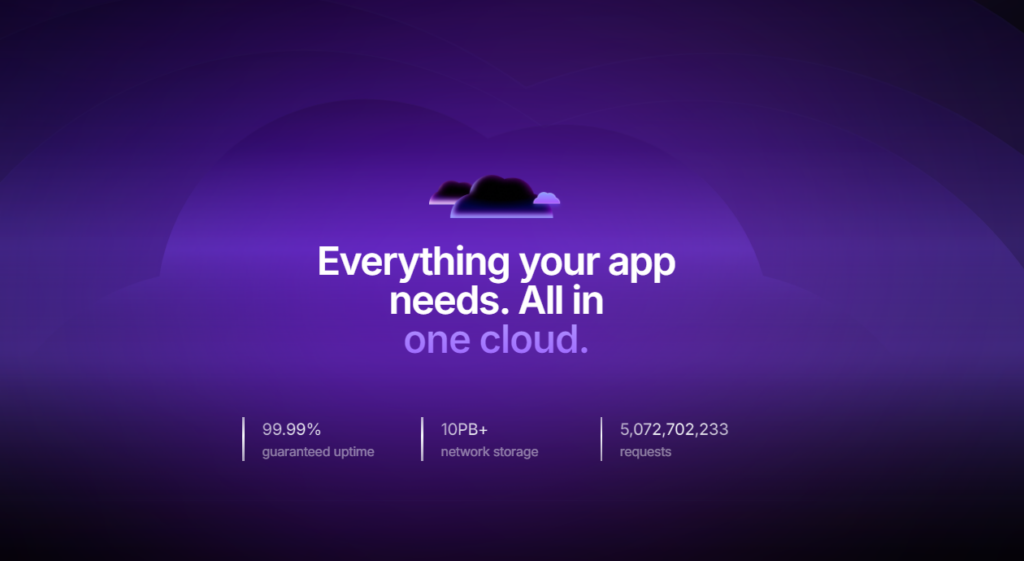
User experience is a vital component of any Runpod review. The platform’s design and ease of use can greatly impact productivity and the overall satisfaction of its users.
1. User Interface
Runpod’s user interface is intuitive and well-organized, making it accessible even for users who are new to cloud computing. The dashboard provides a clear overview of your resources, allowing you to start, stop, and monitor instances with just a few clicks.
2. Setup Process
The setup process is straightforward. Users can launch a GPU instance in just a few minutes, thanks to the pre-configured environments and easy-to-follow setup guides. This simplicity reduces the learning curve and allows users to focus on their projects rather than on setting up the environment.
3. Customer Support
Runpod offers multiple support channels, including a comprehensive knowledge base, email support, and a community forum. The platform’s support team is responsive and knowledgeable, providing quick assistance for any issues that may arise.
Pros and Cons of Runpod
Every platform has its strengths and weaknesses, and Runpod is no exception. Here’s a breakdown of the pros and cons based on this Runpod review:
Pros
- Flexible Pricing: The pay-as-you-go model allows users to control costs effectively, paying only for the resources they use.
- Scalability: Users can easily scale resources up or down based on their needs, making Runpod ideal for dynamic workloads.
- User-Friendly Interface: The intuitive dashboard makes it easy to manage resources, even for beginners.
- Pre-Configured Environments: Saves time by providing pre-configured environments for popular machine learning frameworks.
- API Access: Advanced users can automate processes and integrate Runpod into existing workflows through its robust API.
Cons
- Storage and Data Transfer Costs: While GPU pricing is competitive, storage and data transfer fees can add up quickly, especially for large-scale projects.
- Limited Support for Other Accelerators: As of now, Runpod primarily offers NVIDIA GPUs, which may be limiting for users looking for other hardware options.
- Dependence on Internet Connection: Like all cloud services, Runpod’s performance is heavily reliant on a stable and fast internet connection. Any disruptions can impact workflow.
Competitors and Alternatives to Runpod
While Runpod offers a robust set of features, it’s essential to consider how it stacks up against other cloud computing platforms. Here’s a quick comparison with some of its main competitors:
1. AWS (Amazon Web Services)
AWS offers a broader range of cloud services and global reach. However, its GPU instances can be more expensive than Runpod, especially for short-term projects. AWS also provides additional services like data lakes and machine learning tools, making it a more comprehensive, albeit more complex, solution.
2. Google Cloud Platform (GCP)
Google Cloud provides powerful GPU instances with seamless integration into Google’s ecosystem. It is a popular choice for users already using other Google services but may be costlier and more complex than Runpod for straightforward GPU tasks.
3. Paperspace
Paperspace offers a similar range of GPU instances and a user-friendly interface. It also provides pre-configured environments and a focus on AI and ML tasks. While Paperspace and Runpod are comparable in many aspects, Runpod’s pricing structure and simplicity give it a slight edge for beginners.
Use Cases for Runpod
Understanding the practical applications of Runpod can help you determine if it’s the right platform for your needs. Here are some of the most common use cases:
1. Deep Learning and AI Research
Runpod is an excellent choice for AI researchers and developers who need powerful GPUs for training and testing complex models. The platform’s flexibility and cost-efficiency make it accessible for both academic and commercial projects.
2. 3D Rendering and Animation
For users in the creative industry, Runpod offers the computational power needed for rendering high-quality 3D graphics and animations. The on-demand nature of the service allows artists to scale their resources based on project requirements.
3. Data Science and Analysis
Data scientists can benefit from Runpod’s ability to handle large datasets and perform complex computations. The pre-configured environments and easy integration with data tools make it a convenient option for data analysis.
Conclusion
In this Runpod review, we’ve explored the various features, pricing, performance, and use cases of this cloud computing platform. Runpod offers a compelling solution for anyone needing access to powerful GPU resources without the upfront costs and maintenance hassles of physical hardware. Its user-friendly interface, flexible pricing, and robust performance make it a strong contender in the cloud computing market.
While there are some limitations, such as storage costs and reliance on NVIDIA GPUs, the platform’s advantages outweigh its drawbacks for most users. Whether you’re an AI researcher, data scientist, or creative professional, Runpod provides the computational power and flexibility needed to tackle complex projects efficiently.

